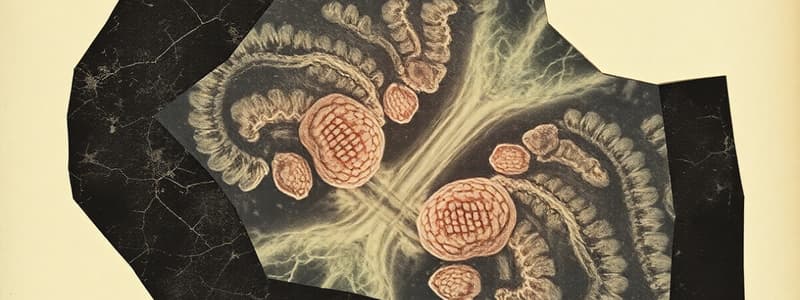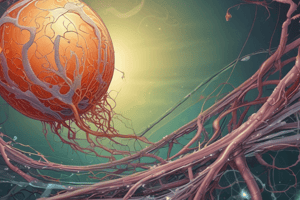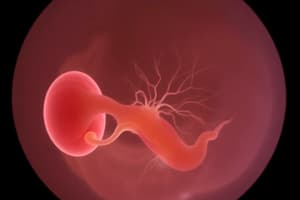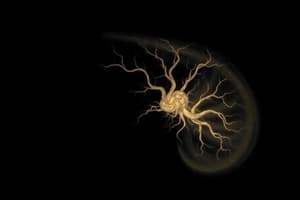Podcast
Questions and Answers
Failure of the cranial neuropore to close around the 25th day of development results in which condition?
Failure of the cranial neuropore to close around the 25th day of development results in which condition?
- Microcephaly
- Spina bifida occulta
- Hydrocephalus
- Anencephaly (correct)
Which of the following developmental structures gives rise to the ganglia of the body?
Which of the following developmental structures gives rise to the ganglia of the body?
- Neuroblasts (correct)
- Chromaffin cells
- Melanocytes
- Spongioblasts
The ventricular system of the brain is derived from which of the following?
The ventricular system of the brain is derived from which of the following?
- The cranial part of the neural tube.
- The cavity of the neural tube. (correct)
- The caudal part of the neural tube.
- The neural crest cells.
During neurulation, what structure is formed by the fusion of neural folds?
During neurulation, what structure is formed by the fusion of neural folds?
Which of the following best describes the origin of neural crest cells?
Which of the following best describes the origin of neural crest cells?
Chromaffin cells, which contribute to the suprarenal medulla and carotid bodies, are derived from what embryonic structure?
Chromaffin cells, which contribute to the suprarenal medulla and carotid bodies, are derived from what embryonic structure?
A defect in the closure of the caudal neuropore during neural tube development would most likely result in which condition?
A defect in the closure of the caudal neuropore during neural tube development would most likely result in which condition?
What is the correct order of the following structures during the process of neurulation?
What is the correct order of the following structures during the process of neurulation?
Which of the following structures is derived from the prosencephalon?
Which of the following structures is derived from the prosencephalon?
The obstruction of the aqueduct of Sylvius is most directly associated with which of the following conditions?
The obstruction of the aqueduct of Sylvius is most directly associated with which of the following conditions?
Which part of the developing neural tube forms the spinal cord?
Which part of the developing neural tube forms the spinal cord?
What is the defining characteristic of spina bifida occulta?
What is the defining characteristic of spina bifida occulta?
From which primary brain vesicle does the pons and cerebellum originate?
From which primary brain vesicle does the pons and cerebellum originate?
Which structure directly precedes the formation of the neural tube during embryonic development?
Which structure directly precedes the formation of the neural tube during embryonic development?
Which of the following gives rise to the pia and arachnoid mater?
Which of the following gives rise to the pia and arachnoid mater?
What brain region is derived from the mesencephalon?
What brain region is derived from the mesencephalon?
Which of the following anomalies is characterized by an abnormal ventricular system due to CSF accumulation?
Which of the following anomalies is characterized by an abnormal ventricular system due to CSF accumulation?
The telencephalon gives rise to what structure?
The telencephalon gives rise to what structure?
During neurulation, the neural groove is located:
During neurulation, the neural groove is located:
Failure of the caudal neuropore to close properly can result in:
Failure of the caudal neuropore to close properly can result in:
Considering the derivatives of the neural crest cells, if a genetic mutation disrupted the normal development of spongioblasts, which of the following structures would most likely be affected?
Considering the derivatives of the neural crest cells, if a genetic mutation disrupted the normal development of spongioblasts, which of the following structures would most likely be affected?
During neurulation, the neural tube separates from the ectoderm. What cellular process is most critical for ensuring this separation occurs correctly, preventing neural tube defects?
During neurulation, the neural tube separates from the ectoderm. What cellular process is most critical for ensuring this separation occurs correctly, preventing neural tube defects?
Which of the following scenarios would most directly lead to hydrocephalus?
Which of the following scenarios would most directly lead to hydrocephalus?
A research team is studying the expression of specific transcription factors during the formation of the neural tube. If they observe a complete absence of Pax6 expression, which of the following processes would most likely be disrupted?
A research team is studying the expression of specific transcription factors during the formation of the neural tube. If they observe a complete absence of Pax6 expression, which of the following processes would most likely be disrupted?
During a prenatal ultrasound, a physician observes that a fetus has an abnormally small head circumference (microcephaly). Considering the developmental origins of the brain, which of the following underlying cellular processes is most likely impaired in this case?
During a prenatal ultrasound, a physician observes that a fetus has an abnormally small head circumference (microcephaly). Considering the developmental origins of the brain, which of the following underlying cellular processes is most likely impaired in this case?
A researcher is investigating the role of cell adhesion molecules during neural tube closure. If they introduce a mutation that disrupts the function of N-cadherin specifically in the neural folds, what would be the most likely outcome?
A researcher is investigating the role of cell adhesion molecules during neural tube closure. If they introduce a mutation that disrupts the function of N-cadherin specifically in the neural folds, what would be the most likely outcome?
If the rhombencephalon failed to properly differentiate during embryonic development, which of the following structures would most likely be affected?
If the rhombencephalon failed to properly differentiate during embryonic development, which of the following structures would most likely be affected?
During the formation of the ventricular system, an obstruction occurs at the cerebral aqueduct (aqueduct of Sylvius). Which of the following ventricles would be most directly affected?
During the formation of the ventricular system, an obstruction occurs at the cerebral aqueduct (aqueduct of Sylvius). Which of the following ventricles would be most directly affected?
A genetic study reveals a mutation affecting the expression of sonic hedgehog (SHH) specifically in the notochord. Which of the following developmental processes would be most directly impacted?
A genetic study reveals a mutation affecting the expression of sonic hedgehog (SHH) specifically in the notochord. Which of the following developmental processes would be most directly impacted?
Failure of neuroblasts to properly differentiate during neural crest development would most directly affect:
Failure of neuroblasts to properly differentiate during neural crest development would most directly affect:
Assuming a teratogen exposure specifically disrupts the development of the telencephalon, which resulting condition would be most anticipated?
Assuming a teratogen exposure specifically disrupts the development of the telencephalon, which resulting condition would be most anticipated?
During early neural tube development, the alar plate and basal plate form. If the morphogenic signals guiding the development of the alar plate were disrupted, what type of neurons would be most affected?
During early neural tube development, the alar plate and basal plate form. If the morphogenic signals guiding the development of the alar plate were disrupted, what type of neurons would be most affected?
If the expression of fibroblast growth factor 8 (FGF8) is significantly reduced at the anterior neural ridge during early brain development, which structure formation is most likely to be impaired?
If the expression of fibroblast growth factor 8 (FGF8) is significantly reduced at the anterior neural ridge during early brain development, which structure formation is most likely to be impaired?
In a scenario where the intermediate cell mass fails to develop properly during kidney formation, which related system could also exhibit abnormalities due to proximity during development?
In a scenario where the intermediate cell mass fails to develop properly during kidney formation, which related system could also exhibit abnormalities due to proximity during development?
Which cellular event is an essential step in the transformation of the neural plate into the neural tube?
Which cellular event is an essential step in the transformation of the neural plate into the neural tube?
If the diencephalon fails to develop properly, which sensory or motor function impairment would be most expected?
If the diencephalon fails to develop properly, which sensory or motor function impairment would be most expected?
Disruptions in the normal signaling pathways during mesencephalon development, leading to malformation, would most likely impact which function?
Disruptions in the normal signaling pathways during mesencephalon development, leading to malformation, would most likely impact which function?
What specific developmental event is critically dependent on the proper functioning of the organizer region during neurulation?
What specific developmental event is critically dependent on the proper functioning of the organizer region during neurulation?
In the context of neural tube defects, what distinguishes spina bifida with myelocele from spina bifida with meningocele?
In the context of neural tube defects, what distinguishes spina bifida with myelocele from spina bifida with meningocele?
What would be the most significant consequence if somite development was disrupted?
What would be the most significant consequence if somite development was disrupted?
Flashcards
Neurulation
Neurulation
Formation of the neural tube in embryonic development.
Neural Plate
Neural Plate
Thickened region of the epiblast above the notochord, forming the basis of the neural tube.
Neural Groove
Neural Groove
Median groove at the center of the neural plate, eventually forming the neural tube.
Neural Fold
Neural Fold
Signup and view all the flashcards
Neural Tube
Neural Tube
Signup and view all the flashcards
Neural Crest Cells
Neural Crest Cells
Signup and view all the flashcards
Prosencephalon
Prosencephalon
Signup and view all the flashcards
Telencephalon
Telencephalon
Signup and view all the flashcards
Diencephalon
Diencephalon
Signup and view all the flashcards
Mesencephalon
Mesencephalon
Signup and view all the flashcards
Rhombencephalon
Rhombencephalon
Signup and view all the flashcards
Metencephalon
Metencephalon
Signup and view all the flashcards
Myelencephalon
Myelencephalon
Signup and view all the flashcards
Hydrocephalus
Hydrocephalus
Signup and view all the flashcards
Anacephaly
Anacephaly
Signup and view all the flashcards
Microcephally
Microcephally
Signup and view all the flashcards
Spina Bifida
Spina Bifida
Signup and view all the flashcards
Spina Bifida Occulta
Spina Bifida Occulta
Signup and view all the flashcards
Spina Bifida with Meningocele
Spina Bifida with Meningocele
Signup and view all the flashcards
Spina Bifida with Meningo-myelocele
Spina Bifida with Meningo-myelocele
Signup and view all the flashcards
Fate of cranial neural tube
Fate of cranial neural tube
Signup and view all the flashcards
Fate of caudal neural tube
Fate of caudal neural tube
Signup and view all the flashcards
Neuroblasts derivatives
Neuroblasts derivatives
Signup and view all the flashcards
Melanocytes derivatives
Melanocytes derivatives
Signup and view all the flashcards
Spongioblasts derivatives
Spongioblasts derivatives
Signup and view all the flashcards
Chromaffin cells derivatives
Chromaffin cells derivatives
Signup and view all the flashcards
Odontoblast
Odontoblast
Signup and view all the flashcards
Study Notes
Neurulation
- Neurulation is the formation of the neural tube
- The neural plate is a thick epiblast located above the notochord
- The neural groove is the median groove at the center of the neural plate
- The neural fold has two folds on each side of the neural groove
- Fusion of neural folds is followed by separation of the neural tube from the epiblast
- The cranial and caudal neuropores close on the 25th and 27th days, respectively
- The cranial part of the neural tube dilates to form the brain
- The caudal part of the neural tube forms the spinal cord
- The cavity of the neural tube forms the ventricular system
Neural Crest Cells
- Neural crest cells are neuro-ectodermal cells that separate from the ectoderm during the fusion of neural folds to form the neural tube
- Neuroblasts, melanocytes, spongioblasts, chromaffin cells and odontoblast are derived from neural crest cells
- Neuroblasts give rise to almost all ganglia of the body
- Melanocytes are pigment cells of the skin
- Spongioblasts give rise to Schwann cells, pia, and arachnoid mater
- Chromaffin cells give rise to the suprarenal medulla and carotid bodies cells.
Brain Division
- The prosencephalon, or forebrain, subdivides into the telencephalon and diencephalon
- The telencephalon forms the cerebral hemisphere and contains the lateral ventricle
- The diencephalon forms the thalamus, hypothalamus, subthalamus, and epithalamus and contains the third ventricle
- The mesencephalon forms the midbrain and contains the aqueduct of Sylvius
- The rhombencephalon, or hindbrain, contains the fourth ventricle, and is divided into the metencephalon and myelencephalon
- The metencephalon gives rise to the pons and cerebellum
- The myelencephalon gives rise to the medulla
Anomalies
- Hydrocephalus is abnormal dilation of the ventricular system due to CSF accumulation, often from obstruction of the aqueduct of Sylvius
- Anacephally is caused by failure of the cranial neuropore to close by the 25th day
- Microcephaly is a smaller than normal head circumference
- Spina bifida involves failure of vertebral arch fusion, especially in the lumbo-sacral region, and has three types: occulta, meningocele, and meningo-myelocele
- Spina bifida occulta is asymptomatic and affects 10% of newborns, where the deficient area is covered by a tuft of hair
- Spina bifida with meningocele has normal spinal cord with meninges projecting via the deficient area
- Spina bifida with meningo-myelocele involves the spinal cord and meninges projecting via the deficient area
Studying That Suits You
Use AI to generate personalized quizzes and flashcards to suit your learning preferences.




